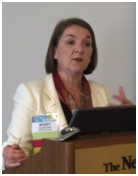“I’m Done”

Several years ago I was in California’s central valley to facilitate training sessions for a large organization with many locations. It was well over 110 degrees and despite the low humidity, it felt very hot. I had spoken with my contact the day before to make sure that all of the details for the sessions were taken care of, but when I arrived at the training location the laptop that was needed to convey the information that I was there to share via Power Point was not in the training room. My contact did not recall confirming that she would provide said laptop during our conversation the day before and after emitting a long sigh, said that she would go and find one. The room was inside of a large trailer as the client’s office building was under construction, so my contact did not have to go very far to find a laptop. In fact, she just stepped outside of the door of the training room and returned a moment later with a plastic supermarket bag. The bag contained a laptop which she proceeded to look at along with its corresponding power cord as if unsure how the two objects were related. I offered assistance and asked her if she knew how to use the laptop and projector which needed to be connected within the next few minutes if I was going to be able to use them for the upcoming session. She responded as follows: “I’m an omelet.” I was not sure if I had heard her correctly, so I asked her if she said ‘omelet’. She responded, very slowly: “Yes, I’m an omelet. I’m done. I am tired of learning things just so that other people can use them.” I asked if she had any use for the computer and she said that she was retiring in a few months and did not see any reason to learn anything new. “I am here just to set up the training room.” She shared that she had almost completed her bachelor’s degree, with only one course to go, but did not see the point in finishing. I suggested that since she was retiring that she might use some of her new found free-time to take that one last class, to which she snorted, “Why?” What a profoundly sad woman! How could anyone not want to learn something new every day?
Learning as a key to Inclusion

Last week I facilitated a panel titled, “Driving Innovation for Greater Business Results” at NALC NY (DiversityBest Practices Network and Affinity Leadership Congress). When one is presenting at a conference the conference fee is usually waived, encouraging speakers to attend the entire event including other speakers’ sessions. NALC is organized with three tiers of sessions: Emerging ERG Leaders, ERG Program Managers, and Experienced ERG Leaders. Employee Resource Groups are groups that facilitate the development and engagement of employees and are usually centered on a common interest or affinity shared by its members such as a women’s group, LGBT group, etc. As I have been in the field of diversity and inclusion for many, many years I find that it is rare that I learn something new at conferences. I was pleasantly surprised and happy that I attended all of the sessions at NALC that I could since I did learn new things. I learned from the seasoned presenters, from the panelists at my session and other sessions and from the other conference participants while practicing what I preach about listening and learning as critical elements of inclusion. One has to be open to listening – really listening or actively listening – to someone regardless of whether they have less experience in one’s field or are a competitor if one wants to really learn something new.
Reach & Teach

My dear friends Craig Wiesner & Derrick Kikuchi give all of us who are hungry for new information lots to fill up on with their company Reach & Teach! “Reach And Teach, the peace and social justice learning company, is helping to transform the world through teachable moments. We offer books, games, puzzles, toys, curriculum, music, posters, DVDs, maps, and other products for people of all ages.” Reach & Teachhas been an online business since 2004 and they are about to move into their new location @ 144 West 25th Avenue, San Mateo, CA. (In case you are fortunate enough to be in the area!) Going into Craig & Derrick’s shop is an amazing experience! Craig & Derrick’s love of learning is contagious and the two of them come at you with an array of books, games, origami, and some of the best puzzles around. It is always difficult for me to tear myself away from the wonderland of inclusive learning that they have created!

Learn from Everyone!
I recommend that we try to be open to learning from everyone, not just the ‘expert’ at the front of the room, but from everyone in the room and those who are not in the room, too. We even have the opportunity to learn from those who may not be inspired or curious, those who are “here just to set up the training room.” We have the opportunity to learn from the person squished in next to us on the subway, and on line in front of us at the supermarket, and from the marginalized in all places in society. Who have you learned from today?
Onward,
~ Wendy
Inclusion Strategy Solutions LLC



